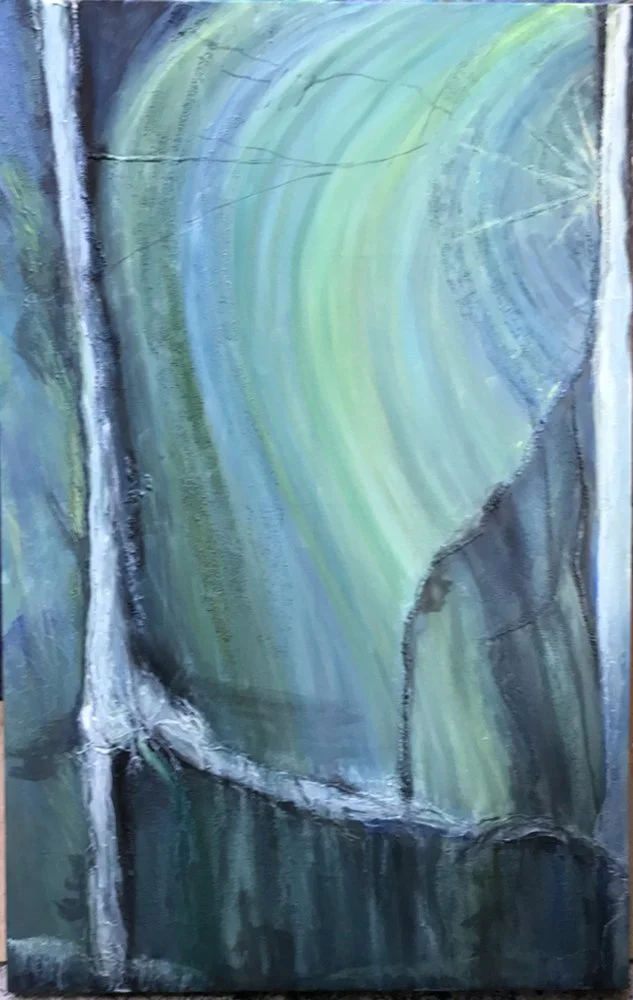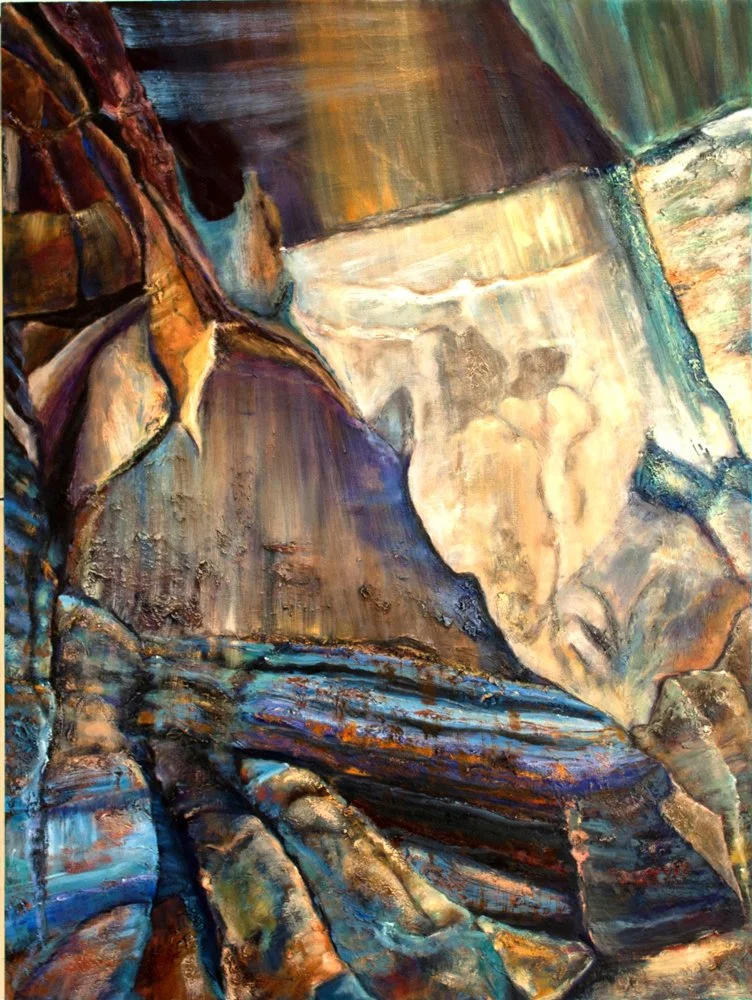Pachamama Paintings
In autumn 2017, I traveled to the heartland of the Inca empire in Peru and to the Galapagos Islands in Ecuador; I realized a life-long dream. Exploring and adventuring are part of my nature. I was excited to see something new and special. But I had no inkling that this experience would change me.
I spent a week in the land of the Incas: Cuzco, the Sacred Valley, and Machu Picchu. Cuzco — I found myself surrounded by remnants of Inca architecture. The Spanish colonists built on the ruins of Inca walls as foundations for buildings in their own style. There is a wall containing a famous stone cut with twelve facets, fitting all the surrounding stones—many of which had been cut to fit adjacent stones front to back, top to bottom. The stones, slightly wedge-shaped, combine their weight against each other to strengthen the walls’ “community of stones.” How the Inca builders accomplished this is a mystery.
I got the feeling that the Inca builders “birthed” each stone, selecting it based on how it would fit with each surrounding stone. Could they somehow have seen inside stone? They had a profound knowing of its nature—a metaphysical connection to the stone, the mountain, the earth. They expressed their knowledge and intimacy with the earth, the Pacha Mama, in every stone they selected, chiseled, and set in their monumental architectural projects.
Ollantaytambo, in the Sacred Valley — my fifth day of immersion in the pervasive living energy of the ancient Inca engineers. Without a guide, I was alone to enjoy the silent drizzle and the majesty of the place. It was like awakening into a dream, a trance. I stood at the bottom of a series of terraces, bounded by two great staircases, built into the rising cliffs. Among these constructs, at various levels, were a maze of roofless, windowed stone rooms and hallways. At the base of this miracle of engineering, I breathed the atmosphere of the Inca respect and love of our living earth. Their humility before the perfect sanctity of the Pacha Mama—source of all life—infused my being and my consciousness. The sun came out, and I started taking pictures of every fascinating rock and crevice I’d seen—seeing with “Inca vision.”
Those stones were my inspiration. I needed to explore the elements of shape, texture, volume, color—to honor the wisdom of the Inca builders. The worldview of the Inca insinuated itself into my heart and into my imagination. A series of paintings, celebrating the sanctity of the earth, source of all life’s nourishment, had never occurred to me. But I found myself deep—joyously deep—in the inner sanctum of the Pacha Mama in Peru. Profound experiences are rare and unexpected. I am grateful that’s what happened to me in Peru and Ecuador.
Sorting through my photos in November when I came home, thirteen rock images emerged as a springboard for this group of canvases: Pachamama paintings. Each is 40” x 26”. The series was completed in August 2018. I created these paintings as a celebration of the magnificent rock—our Mother Earth—who supports all livingness. Her beauty and the reverence the Inca felt for her inspired me. I hope they inspire the same reverence for our sacred planet in you.
Project History: Process
I employed four basic steps in the process of creating the Pacha Mama paintings.
Step 1. The photograph – shooting/editing pictures of rocks.
Out of over a hundred, I selected thirteen images, mostly for their textural interest. It seemed to me the Inca masons regarded texture as one of the most important aspects in their analysis and selection of stones for their buildings. I manipulated the selected images in Photoshop to enhance texture. Through this fortuitous step, unexpected inspiring colors emerged. Additionally, I cropped and resized most of the images so dimensions would be uniform.
Step 2. The diagram – transposing composition, shapes, and textures to the canvases.
The textures presented new technical challenges. I reproduced each image as an 8.5” x 11” black and white image—my basic working diagram. In pencil, I then gridded each print into twelve sections. Using charcoal, I gridded each canvas (40” x 26”) identically. The grid served as a guide for proportion and location of visual elements.
Step 3. The translation – interpreting textural elements on canvas.
Researching materials, I decided molding pastes and glues manufactured for artists, as well as non-skid commercial grits used by house painters, might offer an interesting solution. In the process of preparing the canvases, I discovered a seemingly endless variety of methods for applying the textural elements. Photos of this stage for eleven of the thirteen canvases are presented here. I used a different approach for the first painting in the series, Wall. Instead of applying the texture in advance, I incorporated the texture in the paint itself, so there was no separate textural step. The photo file of the texture of another painting, Sacred Plunge, was corrupted.
Step 4. The coatings – layering color.
I applied paint in multiple translucent coats to express the variations in the rocks—for example, a light coat in some places to express the rocks’ shimmer. I documented the development of each painting. The number of photos for this stage varies from four to twelve, depending on the painting.
Process: Illustration using “Well Spring”
Original photo
Manipulated photo
Gridded black and white print
Gridded canvas with the textural foundation
Through end stages of the development of the painting

Original Photo

Manipulated Gridded Photo

Gridded Black and White

First Layer of Paint






Final Painting – "Well Spring"
Well Spring

Original Photo

Textured Gridded Canva

Final Painting – "Well Spring"
Wall

Original Photo

Gridded Photo

Final Painting – "Wall"
Lure

Original Photo

Textured Canvas

Final Painting – "Lure"
Slide

Original Photo

Textured Canva

Final Painting – "Slide"
Sacred Plunge

Original Photo

Final Painting – "Sacred Plunge"
Crack Up

Original Photo

Textured Canva

Final Painting – "Crack Up"
Wings

Original Photo

Textured Canvas

Final Painting – "Wings"
Sacred Fount

Original Photo

Textured Canva

Final Painting – "Sacred Fount"
Layers

Original Photo

Textured Canva

Final Painting – "Layers"
Rock Star

Original Photo

Textured Canvas

Final Painting – "Rock Star"
Rising

Original Photo

Textured Canvas

Final Painting – "Rising"
Triangles

Original Photo

Textured Canva

Final Painting – "Triangles"
